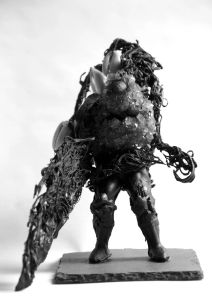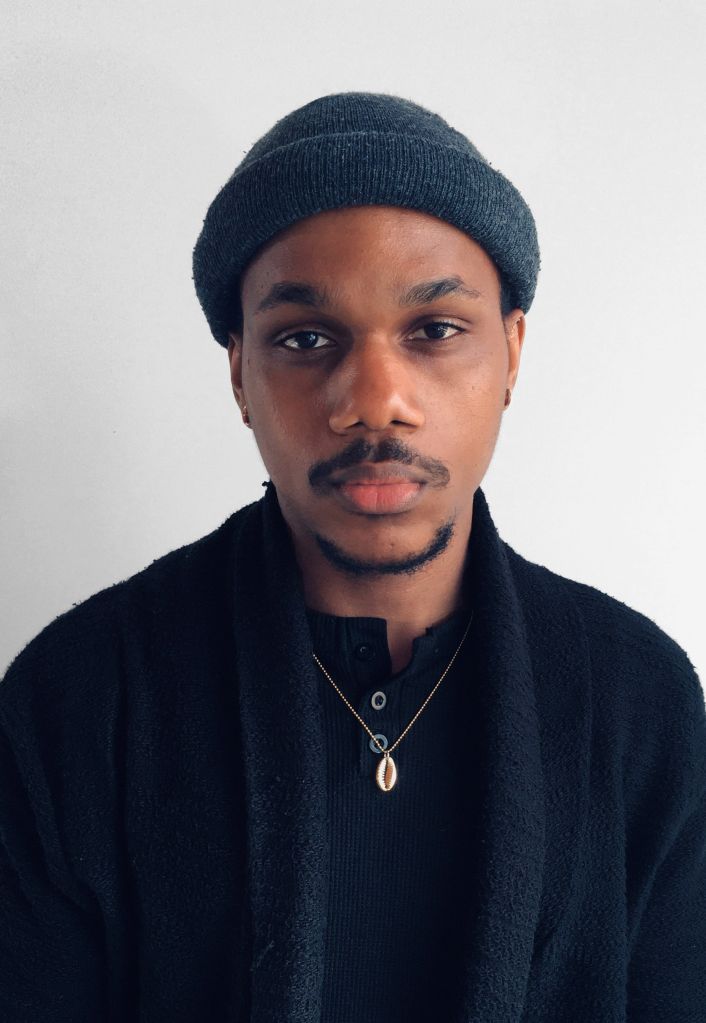The Joy, Pain, Love And Art Of Marvin Touré

Source: iOne Digital Creative Services
Ivorian-American Marvin Touré is an interdisciplinary artist who uses fictional narratives and the objects of innocence as a vehicle to interrogate themes of love, loss, and memory. He focuses his interdisciplinary practice on connecting with audiences through interactive projects that allow for involuntary participation.
A highly accomplished young artist with an MFA in fine arts from the School of Visual Arts with a residency at the prestigious Skowhegan School of Painting and Sculpture under his belt, the Georgia-raised, Sci-Fi, comics, hip-hop inspired, and gallery nerd has enjoyed an incredible vertical trajectory as a multimedia artist navigating the art world with seemingly no fear or reluctance. His current exhibition titled, “the blood is the water” is on view at the Mattress Factory in Pittsburgh through March 30, 2025.
NewsOne Presents Still Blooming In The Whirlwind: Pittsburgh As A Black Cultural And Artistic Mecca
The work reflects the fragmented ways family history is passed down, Touré’s West African and southern gothic sensibilities, and the aesthetics at play in the artist’s work.

Courtesy of Marvin Touré
Tell us about yourself.
I was born in 1991 in Maryland, Tacoma Park, and not too long after that, moved to Georgia. When I was probably about 3 years old, we moved to Atlanta and I grew up in Atlanta in DeKalb County, with the DeKalb County Public Library, spent a lot of time as a kid looking at books there, then moved to Gwinnett County. After, I stayed in Georgia throughout undergrad. But my entire family is from Côte d’Ivoire, which is in West Africa. It’s a beautiful country. It’s had a lot of history, gained its independence in 1960, which coincidentally was the same year my dad was born, which I always keep that in mind thinking about how long we have been free from colonization, in regard to autonomy as a people. I keep that in mind to think about the distance that we have been since the 1960s, because it’s not that far away. Perspective-wise I carry that.
Give us three words that describe you.
Benevolent Sith Lord might be three words to describe me. I think that’s me in a nutshell.
Your background is architecture, you’re an installation artist and sculptor. What is the connection between your practice and the materials you use?
When I was younger, I grew up watching my mom be extremely creative, a lot of crafts, a lot of artwork. She really got me into being creative in that way. I used to sneak into her sewing studio to see the dresses and the African fabrics and all this other stuff that she was cutting and bringing in that style, bringing in fabrics, but then combining them with silhouettes, at that time ’90s silhouettes, make outfits and things—even down to us making Rice Krispies Treats together.

“Paranoia’s Prodigy” by Marvin Toure’. | Courtesy of Marvin Touré
I watched my father work on his car because we didn’t have money to just go to the dealership. He worked to learn the vehicle so that he could fix it himself. And he would drive this 280Z Nissan and then he had a 300ZX Turbo. Those were the cars that we used to take road trips in throughout the South growing up. And it was something about watching both use their hands working through ways of being creative in one way or another.
When I came to study architecture in undergrad, materiality was one of the first things we learned. We had this intensive summer workshop this summer where they gave us a tiny X-Acto knife, probably no larger than this pen, and just large sheets of cardboard. And then they were like, “Go, study materiality. We need 12 study models by tomorrow.” We were just like, “What do you mean?” They’re like, “Study materiality.” So, we learned to delaminate, peeling apart the layers of the cardboard to figure out the corrugation. And then if we stack this many cardboard pieces together, it gets more structural, and if we rip it apart, it doesn’t, if you put it this way. And then how do you do the corrugation to enhance light coming through or something like that?
It was homegrown, but then refined in my formal studies of architecture where materiality is incredibly important, and there’s just something about that I took from that into my interdisciplinary practice. I like to bring people into the texture of things, that brings people into an experience. That’s what I’m really interested in creating.

“X.12” from Marvin Toure’s “Figure27 the (X) mutation.” | Courtesy of Marvin Touré
How does lineage from the Ivory Coast factor into your art practice?
The source material. My exhibition at the Mattress Factory Museum here in Pittsburgh called “the blood is the water” engages with stories that I collected from my family. I was always the kid sitting at the knees of my elders to listen to their stories. That’s benefited me now because I have all those stories. So, the way that it’s influenced my practice is that it allowed me to connect what I do now to centuries ago.
In your piece “Paranoia’s Midnight,” you define paranoia as a “hyperawareness,” and you reference James Baldwin with his quote about being “relatively conscious.” Baldwin is thinking about a condition. With your work, you are referencing spaces. Tell us more about this.
I’m talking about racialized paranoia. Paranoia is this feeling of this fear, this nebulous sort of uncertainty that something is coming, something is happening around the corner that you may or may not have evidence for. It’s a similar thing in “Black Bile Toys,” where I’m talking about melancholy, which is a nebulous sadness. For me, as the James Baldwin, it’s the awareness that comes with being informed to some degree about where you fit in Western societies that are based on heteronormative patriarchal white supremacy.
I think there’s anger, but it’s never just one note. It’s never just like, I’m mad. It’s like, what is the nuance of that rage? What is the nuance of that heated discomfort? And because my work is rooted in autobiographical studies, it manifested as never really knowing if an interaction that I was having with someone was based off the way I present walking into a room or something else that wasn’t there. Half of my family is Muslim; the other half is Christian. I’ve been racially profiled at a Christian bookstore. I’ve also been pointed out and chastised in a mosque growing up as a kid and being the only Black kid at that mosque.
Whether growing up in the South or when I moved to New York City, experiencing the most overt racism, it starts to affect the way you move, it starts to affect the way you perceive how others perceive you. There’s a defense mechanism or a callus that starts to build with a lot of these racial incidents. It transformed me. “Paranoia’s Midnight” was about never really feeling whole, never really feeling like you can walk on sure footing because of it.

“Big Cry,” from Marvin Touré’s “Black Bile Toys.” | Courtesy of Marvin Touré
How did all of this affect the art?
The way in which I manifested that spatially was to create an installation where the objects were 8-inch plaster replicas of myself made from a 3D print. The ground that they staged in was also made of plaster. So, it was just pared-down plaster broken into pieces. All the individual sculptures were imperfect and manipulated from one cast to the next. It was in a way to bring people into that experience of engaging with all these different objects that were in distress—and not really telling people how to engage with it.
So, they are walking in this gallery space and then there’s this broken plaster on the ground. There’s no, “Do not touch,” signs, so somebody even walked across it during the opening. You’re walking on this ground that’s crumbling underneath you while these 8-inch lifelike figures are looking up at you in distress and crumbling and imperfect. The threshold that I approached that project from was to create an uneasy experience.
With the “{Fig. 27} The {X} Mutation,” you create inextricable connections within the most mundane experiences: love, regret, loss, joy. Why is this a mutation for us when it is the topic of the latest romantic comedy for others?
What I was talking about in “{Fig. 27},” the unknown mutation was the question of what if our emotional responses to these everyday occurrences manifested themselves as physical mutations? So, if every time you fell in love, you grew a vine on your arm, what would you look like at the age of 60? If every time you experienced loss, you grew a golden crystal on your shoulder, what would you look like at 30? If every time you experienced racism, you grew this shell, what would you look like at 70? That was the premise of the unknown mutation.
How does joy factor into your work?
Joy factors in a lot now. But joy in my work hasn’t always been a companion because in the past I was making work from a place of pain. I was making work from a place of being in it. There was some guilt around having too much fun in the work because of the topics that I’m talking about. There’s a freedom that came in allowing myself to find processes, find ways of making, find the way in which I’m talking about things to be enjoyable for me.

Source: Courtesy of Marvin Touré
What’s next for you?
I’m using a recently awarded grant to secure a studio (multi-year) with safe working conditions, additional fabrication support and exhibition public program funding. I also have a solo exhibition, “the blood is the water,” at the Mattress Factory here in Pittsburgh. It will be up until March of 2025.
Stacey A. Robinson is a graphic novelist, exhibitor, curator, DJ, and an Associate Professor of Graphic Design, and Studio at the University of Illinois at Urbana-Champaign. His work appears in Lee and Low Books, Abrams Books, Rosarium Publishing, and Carnegie Hall.
SEE ALSO:
For Choreographer Staycee Pearl, The Future Is Now
LoRen Is Pittsburgh’s Fire Starter
The post The Joy, Pain, Love And Art Of Marvin Touré appeared first on NewsOne.





